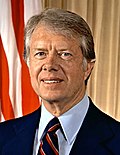 | |
| Long title | An Act to provide for an accelerated program of research, development, and demonstration of solar photovoltaic energy technologies leading to early competitive commercial applicability of such technologies to be carried out by the Department of Energy, with the support of the National Aeronautics and Space Administration, the National Bureau of Standards, the General Services Administration, and other Federal agencies. |
|---|---|
| Acronyms (colloquial) | SPERDDA |
| Enacted by | the 95th United States Congress |
| Effective | November 4, 1978 |
| Citations | |
| Public law | 95-590 |
| Statutes at Large | 92 Stat. 2513 |
| Codification | |
| Titles amended | 42 U.S.C.: Public Health and Social Welfare |
| U.S.C. sections created | 42 U.S.C. ch. 71,subch. III § 5581 et seq. |
| Legislative history | |
| |
Solar Photovoltaic Energy Research, Development, and Demonstration Act of 1978 is a United States statute authorizing the research and development of photovoltaic systems utilizing solar irradiance or sunlight as a source for electricity generation. The Act of Congress promotes energy conservation by the displacement of conventional energy systems dependent upon alternative fuel and fossil fuel resources.
Contents
- Provisions of the Act
- Associated United States Federal Statute
- See also
- References
- United States Presidential Communiqués
- Bibliography
- External links
The H.R. 12874 legislation was passed by the 95th U.S. Congressional session and enacted into law by the 39th President of the United States Jimmy Carter on November 4, 1978. [1] [2]

